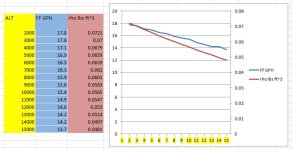Illustration, AFP FM-200, IO-390, WOT and full rich from 200 to 15000 feet. Bendix-type metering is based on velocity and density, so it tracks the density loss due to altitude rather well for a purely mechanical device. However, it's not
perfect, and does moderately drift rich as density is reduced.
Progressively leaning in the climb to maintain the EGT noted immediately after takeoff simply makes the blue fuel flow line track the red density line.
Concerned about leaning at WOT? Note the EGT seen immediately after liftoff from sea level is based on a fuel/air ratio necessary to maintain detonation margin, based on certification tests, which are run at worst case temperature. Leaning to keep the blue line matched to the red line merely maintains the same ratio, and thus provides no basis for a detonation concern based on mixture. If CHT's get too hot, it's because cooling system performance is inadequate.
View attachment 57048






